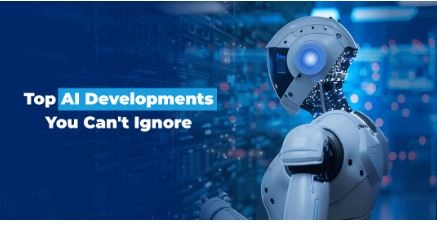Stories you may like
Top 5 AI Developments of 2025 You Can’t Ignore for 2026
Why 2025 is a turning point for AI?
2025: the year AI ceases to be a pilot project and becomes the default layer in products, workflows, and customer experiences. Several changes are converging:
- Agentic AI is moving beyond chat to take actions across enterprise apps.
- On-device & hybrid AI keep sensitive data local while tapping the cloud for heavy lifting—improving privacy, resilience, and latency.
- Infrastructure jumps (e.g., next‑gen GPUs and application‑specific accelerators) are reducing training/inference expense while enabling multi‑model deployments.
- AI‑native search and discovery are revolutionizing the way customers discover information and how marketers perform SEO.
- Regulation and governance are coming of age, with firm deadlines that businesses have to comply with.
Why AI Developments of 2025 Matter for 2026?
AI is evolving at an exceptional pace. Innovations that emerged in 2025 are not just incremental improvements; they’re laying the foundation for transformative change in 2026.
1. Rapid Pace of AI Innovation
Every year, AI technologies become faster, smarter, and more capable. In 2025, we’ve seen breakthroughs in generative AI, AI-powered automation, and advanced predictive models that are already redefining industries. Staying updated with these trends ensures you’re prepared to leverage the next wave of innovation.
2. Market Adoption and Growth Statistics
The numbers speak for themselves: the AI market is projected to surpass $78 billion by 2030, with millions of active users adopting AI-driven solutions across sectors. Investments in AI startups reached $15 billion, reflecting the high confidence of investors and the rapid commercialization of AI technologies.
3. Competitive Advantage Through Early Adoption
Businesses that implement AI early gain a significant edge—from optimizing operations and reducing costs to creating innovative products and enhancing customer experiences. Understanding the trends of 2025 gives you the roadmap to leap ahead in 2026, rather than playing catch-up.
Top 5 AI Developments Every Business Should Know for 2026
#1. Agentic AI & Copilots
Agentic AI systems are goal‑driven AIs that are capable of planning, calling tools/APIs, and running multi‑step workflows with human approval. Suppose a “copilot” that doesn’t simply respond but accomplishes: writing content, submitting tickets, updating CRM, reconciling invoices, or choreographing a multi‑app workflow.
- Enterprise copilots (e.g., in productivity suites and dev environments) are becoming the norm in addition to knowledge work and software delivery.
- Domain-specific agents (finance, legal, HR, support, supply chain) support high-leverage, repeatable processes with well‑defined guardrails.
- Human‑in‑the‑loop checkpoints and policy‑aware prompts maintain actions auditable and compliant.
Automation & productivity benefits
- Time gain on repetitive activities (document preparation, QA, tagging, ticket triage).
- Increased throughput in sales ops, customer success, and back‑office processing.
- Decision support through retrieval‑augmented generation (RAG) and tool utilization.
- Quality & consistency through templates, style guides, and action policies built into the agent.
Quick win concepts: Agentic knowledge base that responds with citations; auto‑triage and resolution through service‑desk bots; meeting‑to‑task pipelines; code review bots; finance close checklists.
#2. On‑Device & Hybrid AI
On-device AI delivers contextual intelligence to phones, laptops, and IoT endpoints—less network dependence and more privacy‑sensitive use cases unlocked. Hybrid AI solutions blend edge models for real‑time workloads with cloud models for more intensive reasoning, fine‑tuning, or batch analytics.
Why enterprises care:
- Privacy & residency: Sensitive data never leaves the device (PII, PHI, financial).
- Latency: Millisecond‑level responses for assistive UX, industrial control, or AR.
- Cost control: Push frequent, lightweight inference to devices to save cloud expense.
- Resilience: Applications remain functional while the network is interrupted.
Design pattern: Localize small, efficient models for summarization, intent detection, speech, and classification; escalate to more expansive cloud models for challenging reasoning or cross‑org retrieval; selectively sync with policy‑based data pipelines.
#3. AI Infrastructure Expansion
Training frontier models and serving multi‑tenant inference demand require massively parallel computers. The 2025 stack includes next‑gen GPUs and domain‑specific accelerators, increased memory bandwidth, reduced‑latency interconnects, and inference‑optimized instances.
Business implications:
- Faster, less expensive training & fine‑tuning—executable even for mid‑sized companies through managed services.
- Larger context windows & multi‑modal capabilities become feasible at scale.
- Multi‑model routing (pick the best model per task) reduces cost without sacrificing quality.
Enterprise takeaway: When the cost curve turns, projects that were “too costly” in 2024 tend to work in 2025—particularly with mixture-of-models and caching.
#4. AI‑Native Search
Search is evolving from ten blue links to AI-generated answers, multi-turn refinement, and contextual shopping. For businesses, that implies SEO tactics will need to change to supply structured, high-trust content to AI overviews and other aggregators.
Effect on SEO & customer discovery:
- E‑E‑A‑T signals (expertise, experience, author identity, citations) are paramount.
- Structured data (schema.org, product feeds, FAQs) makes eligibility for AI summaries.
- Content for question answering and task fulfillment attracts higher visibility.
- First‑party data & communities become more important as organic traffic trends shift.
Practical actions today: Aggregate topical authority pages, have strong FAQs with citations, include product & review schema, post concise how‑to workflows, and measure attribution beyond last‑click.
#5. Model Ecosystem & Open Source
Model variety is plentiful, with proprietary frontier models for high‑end reasoning and open‑source models for economically priced, private use cases. Multi‑modal is the norm (text, code, image, audio, sometimes video). Long context + tool application + function invocation are table stakes.
How to select for business purposes:
- Task complexity: For high‑stakes reasoning or complicated planning, go with top‑end proprietary models; for ordinary classification/summarization, open models are usually good enough.
- Data sensitivity & residency: Favor on‑prem or VPC‑hosted open models where data should not exit your environment.
- Latency & cost: Small, concentrated models are best for high‑volume, low‑complexity tasks.
- Ecosystem fit: Verify SDKs, connectors, and MLOps support.
- Benchmark on your data: Conduct head‑to‑head tests on representative tasks before committing.
Emerging Technologies Complementing AI Solutions
AI no longer operates in isolation. Its full potential is revealed when combined with other emerging technologies that provide data, speed, security, and connectivity. How the integration works:
1. Internet of Things (IoT) for Smart Environments
- IoT devices generate vast amounts of real-time data from homes, offices, factories, and cities.
- When AI analyzes this data, it enables smart automation, predictive maintenance, energy optimization, and personalized experiences.
2. Blockchain for Secure & Transparent Data Handling
- Blockchain provides immutable, decentralized, and tamper-proof data storage, which is critical for AI systems that rely on accurate and trustworthy datasets.
- Combining AI with blockchain ensures secure decision-making, transparent audit trails, and enhanced trust across industries like finance, supply chain, and healthcare.
3. 5G & Edge Computing for Faster, Decentralized Processing
- 5G networks drastically reduce latency, enabling AI systems to process massive data streams in real time.
- Edge computing moves AI processing closer to the data source (IoT devices, sensors), reducing dependency on centralized servers and cloud networks.






User's Comments
No comments there.